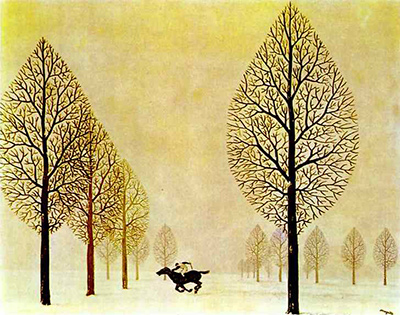Rene Magritte painted a number of works entitled The Lost Jockey (Le Jockey Perdu) during his career. The first, from 1926 is considered to be his first Surrealist work, with earlier works being influenced by Impressionism, Futurism and Cubism.
The 1926 work is in the unusual medium of "Cut-and-pasted sheet music, watercolour, pencil and ink on paper". It depicts a pencil drawn jockey riding a horse through a forest of trees formed from balusters, which are covered in sheet music. Black branches sprout from the top of each baluster. The whole scene is framed by curtains giving it the appearance of taking place on a stage.
The top of one baluster-tree is painted in front of the curtain on the right, giving an uneasy sense of altered perspective. Magritte frequently used balusters in his work although he himself referred to them as bilboquets, using the French word for a cup and ball game.
During the Second World War, and the years immediately after, Magritte would explore several different styles. Bold, colourful works were designed to convey optimism during the dark times of the German occupation of Brussels. 1948 marked a return to the Surrealist style he is best known for, and the re-working of The Lost Jockey from the same year is a good example of this.
The 1948 painting in gouache on paper takes a simpler, purer approach to the scene. The jockey is still riding through the centre of the piece, but the sparse monochrome landscape is truer to real life. The Surrealist aspect comes from the trees, which are painted in a veined manner resembling leaves or blood vessels. Gouache is thickened or opaque watercolour, and was a medium which Magritte used regularly throughout his career.
Magritte painted other versions of The Lost Jockey, for example in 1942, which contained the key motifs of the 1926 painting. The scene of the jockey riding through a forest of balusters has become one of the well known images of his work.




